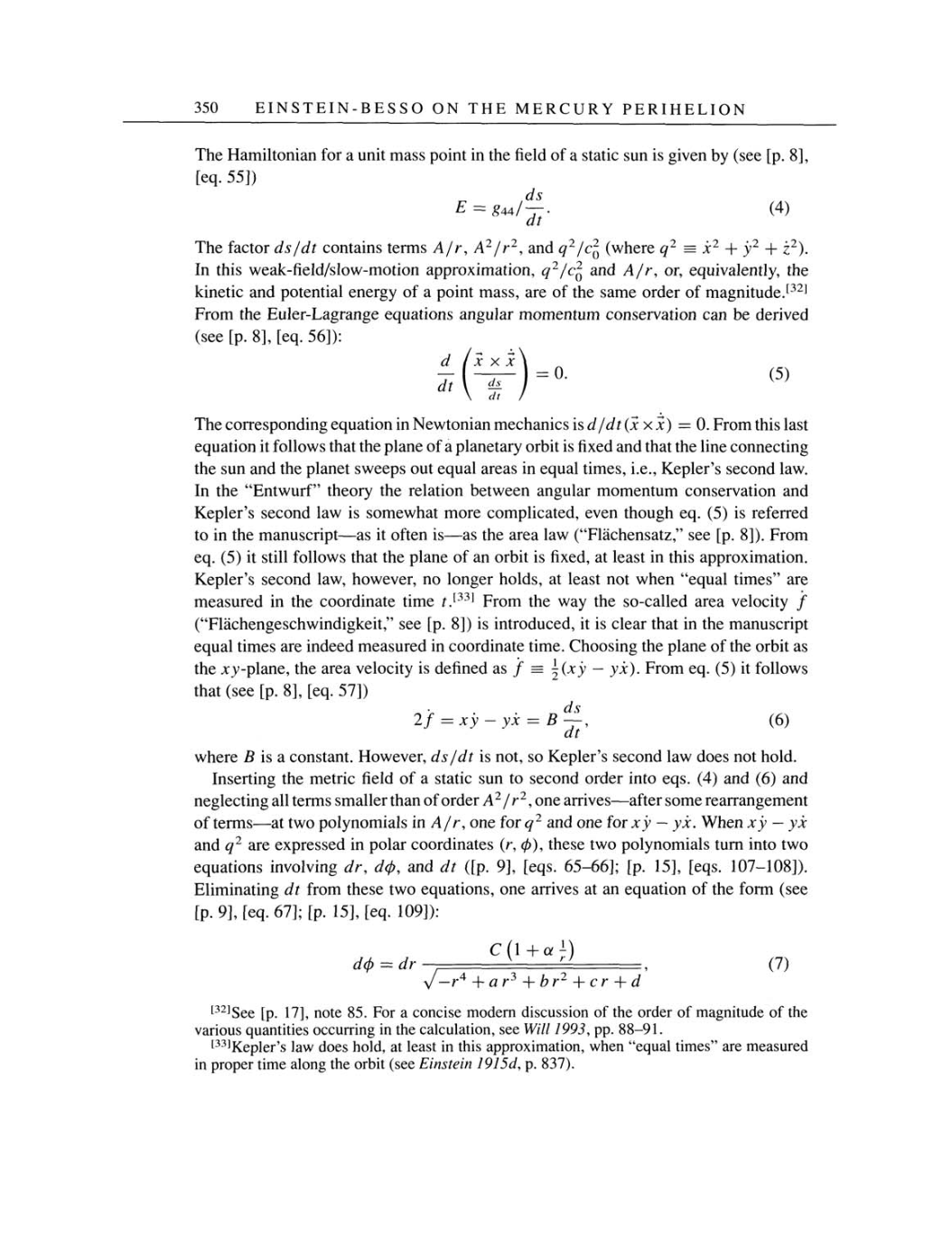350
EINSTEIN-BESSO
ON THE MERCURY PERIHELION
The Hamiltonian for
a
unit
mass
point
in
the
field
of
a
static
sun
is
given by (see [p. 8],
[eq.
55])
ds
E
=
£44/
-.
(4)
The factor ds/dt contains
terms
A/r,
A2/r2,
and
q2/c2 (where
q2
=
x2 +
y2
+
z2).
In
this
weak-field/slow-motion
approximation, q2/c2
and
A/r,
or, equivalently,
the
kinetic and
potential energy
of
a
point mass,
are
of the
same
order of
magnitude.[32]
From the
Euler-Lagrange equations angular
momentum
conservation
can
be derived
(see [p. 8], [eq. 56]):
d
/xxx.•/
=
0.
(5)
dt
ds
dt
The
corresponding equation
in
Newtonian mechanics
is
d/dt
(x
x
x)
-
0.
From
this
last
equation
it
follows that
the
plane
of
a
planetary
orbit
is
fixed
and that
the line
connecting
the
sun
and the
planet sweeps
out
equal
areas
in
equal
times,
i.e., Kepler's
second
law.
In
the "Entwurf"
theory
the relation between
angular
momentum
conservation
and
Kepler's
second law
is
somewhat
more complicated, even though
eq.
(5) is
referred
to in
the
manuscript-as
it often
is-as
the
area
law
("Flächensatz,"
see
[p.
8]).
From
eq.
(5)
it still
follows that the
plane
of
an
orbit
is
fixed,
at least in this
approximation.
Kepler's
second
law,
however,
no
longer holds, at
least
not
when
"equal
times"
are
measured
in
the coordinate time
t.[33]
From the
way
the so-called
area
velocity
f
("Flächengeschwindigkeit," see
[p.
8])
is
introduced, it is
clear that
in
the
manuscript
equal
times
are
indeed measured in coordinate
time.
Choosing
the
plane
of the orbit
as
the
xy-plane,
the
area
velocity
is
defined
as
f
= ^(.xy
-
yx).
From
eq.
(5)
it follows
that
(see
[p.
8],
[eq.
57])
2
f=xy-yx
=
B~,
(6)
at
where
B is
a
constant. However,
ds/dt
is
not,
so
Kepler's
second
law
does
not
hold.
Inserting
the metric
field
of
a
static
sun
to
second order into
eqs.
(4)
and
(6)
and
neglecting
all terms
smaller
than
of
order A2/r2,
one
arrives-after
some
rearrangement
of
terms-at two
polynomials
in
A/r,
one
for
q2
and
one
for
xy
-
yx.
When
xy
-
yx
and
q2 are
expressed
in
polar
coordinates
(r,
0), these
two polynomials
turn
into
two
equations involving
dr,
dcj),
and
dt
([p.
9],
[eqs.
65-66];
[p.
15],
[eqs.
107-108]).
Eliminating
dt
from these
two
equations,
one
arrives
at
an
equation
of the form
(see
[p.
9],
[eq.
67]; [p. 15], [eq.
109]):
C(
1+a1)
d(p
~
dr
--=
(7)
[32]See
[p. 17],
note 85.
For
a
concise modern discussion of the order
of
magnitude
of
the
various
quantities occurring
in
the
calculation,
see
Will 1993,
pp.
88-91.
[33]Kepler's
law
does
hold, at
least
in
this
approximation,
when
"equal
times"
are
measured
in
proper
time
along
the orbit
(see
Einstein
1915d,
p.
837).
